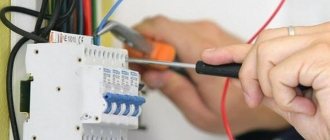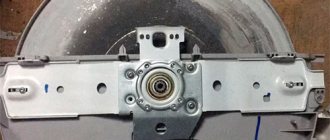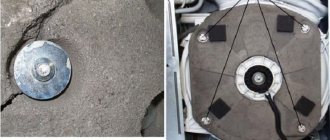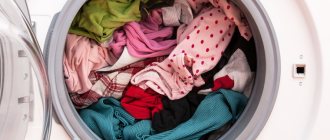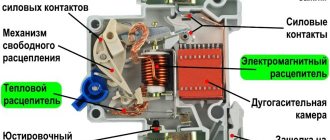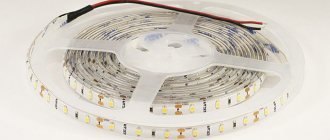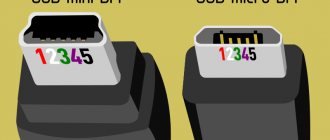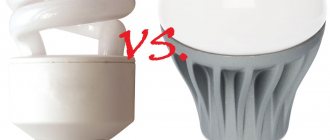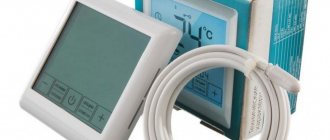Author of the article
Alexander Georgievich Kondratiev
An electrical engineer by training, he worked as an electronics engineer, chief engineer at a food company, and general director of a construction organization.
Many people are interested in how much water and electricity a washing machine consumes. The constant increase in tariffs forces us to use the machine less often. When purchasing a new washing machine, water and energy consumption are taken into account. We calculated how much resources she spends. The good news is that the numbers weren't particularly impressive.
What affects energy consumption
One of the indicators of economical operation is energy consumption. Electricity consumption is influenced by various factors:
- Power of the installed electric motor.
- Operating modes that provide optimal conditions for washing clothes.
- The amount of dirty raw materials deposited at a time.
- How dirty the laundry is loaded into the drum.
- Supply water temperature. The colder it is, the more electrical energy is required to heat it.
The energy consumption of the washing machine is indicated in the passport. During the washing process, the power varies from 300 W to 2 kW. Depends on the brand of the car and the selected mode. For one full cycle, electricity consumption ranges from 0.8 to 2 kW.
How much electricity is consumed to heat water depends on the heating elements installed in the unit. Thus, consumption is determined by the washing mode and engine power.
It should be taken into account that the passport contains data from laboratory tests, which differ significantly from the real ones. The discrepancy can be up to 20% upward.
Factors
Many different factors influence the number of kilowatts consumed by a washing machine.
- Service life of household appliances. That is, the more the washing machine works, the more formations accumulate on the heating element. Such formations significantly complicate the operation of the machine and the process of heating water, accordingly increasing power consumption;
- The type of clothing and fabric also greatly affects the power consumption of the washing machine. The thing is that wet fabric differs from dry fabric in weight and, accordingly, requires different electricity consumption;
- The load on household appliances greatly affects energy consumption. The calculation of the amount of electricity consumed is taken per kilogram of laundry, therefore, the more you load the drum, the more power consumption the washing machine needs;
- The washing program also affects the electricity consumption. It also talks about the temperature required for washing. High temperatures will require large amounts of electricity. A long washing process increases the amount of kilowatts consumed.
Energy class
The energy consumption class is indicated by letters of the Latin alphabet from A to G in kW/kg of laundry. The machines of the subgroup designated by the letter A have the lowest consumption.
In subgroups, “+” signs are used. The more there are, the more economical the unit is. The power consumption of the washing machine is shown in the table below.
| Energy class | Electricity consumption when washing 1 kg of dry laundry |
| A+++ | 0.11 kW/kg |
| A++ | 0.15 kW/kg |
| A+ | 0.17 kW/kg |
| A | 0.17-0.19 kW/kg |
| IN | 0.19-0.23 kW/kg |
| WITH | 0.23-0.27 kW/kg |
| D | 0.27-0.31 kW/kg |
| E | 0.31-0.35 kW/kg |
| F | 0.35-0.39 kW/kg |
| G | More than 0.39 kW/kg |
The industry has stopped producing equipment below class C as economically unprofitable. You can still find such models on sale, but few people buy them. In one cycle they “eat up” 1 kW or more.
"P" value
Power, which determines the rate of energy consumption, plays a key role. Washing machines show performance in the range of 2–4 kW. High numbers are due to the need to heat water and impose special requirements on connecting equipment. Due to restrictions regarding the current carried by the wires. The power of the washing machine is 2.2 kW, the current consumption is 10 A. The throughput of copper wires is 14 A/mm2, the parameter for aluminum wiring is 10 A/mm2. The device, which consumes 2.2 kW, is connected after first calculating the cross-section of the wires.
If P equipment exceeds the cable transmittance, you will need to convert the indicator into amperes using the formula: N (kW) × 4.35 = A. Empirically it looks like this: 4 kW × 4.35 = 17.5 A. Divide the result by the number of square millimeters, stated above. Compare the necessary information. We conclude: connecting a machine with power
, is performed using aluminum wire with a core cross-section of 2 mm2 or copper wire with a cross-section of 1.5 mm2.
How much electricity does a washing machine consume?
Electricity consumption depends on the model, energy consumption class, and selected mode. To calculate, you need to multiply the data from your passport by the tariff in force in the city of residence.
But the data will be incomplete. It is necessary to take into account the number of washes per month. On the Internet you can find information that consumption depends on the design of the machine. This is partly true. But automatic washing machines with the same parameters, front-loading or horizontally loading, consume the same amount of electricity.
Electricity consumption will depend on the selected program and the set water temperature.
Let's take a modern popular model as an example, the Whirlpool FWSD 81283 WCV washing machine:
- Consumption class A+++ with a consumption of 0.11 kW/kg;
- Full load is 8 kg;
- We determine the consumption for one cycle 0.11*8=0.88 kW;
- We take the tariff of the city, for example, in Kursk it is 4.03. We multiply the obtained data by the tariff in kW 0.88 * 4.03 = 3.55 rubles.
We got the approximate electricity consumption for one wash. The average family does laundry 10 times a month. The resulting value is 3.55 rubles. Multiply by 10, we get 35.5 rubles. per month.
But this is a calculated value. It must be adjusted to obtain real values, that is, increased by approximately 15%. We get an approximate consumption of a washing machine per month of 41 rubles.
Often, measuring instruments are installed to accurately determine energy consumption. Perform a washing cycle with maximum load, monitoring the entire process using instruments.
The unit consumes different amounts of electricity in different operating modes. For example, when heating water and simultaneously slowly turning the drum, maximum power consumption occurs.
When draining the water it is minimal. The average value is taken for calculation. To obtain accurate data, connect an electric meter to the washing machine and record the initial readings. After the end of the cycle, the result is obtained, which is multiplied by the tariff.
Main consumers of electricity
To estimate the amount of energy consumed by a washing machine, you need to look at its main components, the parts whose contribution to total consumption is the most significant. There are few main consumers of electricity, but each of them contributes to the final electricity bill.
A heating element
A tubular electric heater (heating element) is one of the most energy-hungry washing machine units in terms of energy consumption. However, it is worth noting that it is not constantly on, but is used only in washing programs with heated water. The amount of electricity it consumes directly depends on the power. For most washing machines, this figure varies in the range from 1.5 to 3.0 kW. The higher this value, the faster the water heats up, and accordingly, the greater the consumption of the machine.
Electric motor
Just like in the case of a heating element, the consumption of the engine depends on its power. Household devices are equipped with motors from 0.4 to 1.0 kW or more. It is worth noting that maximum engine consumption is only possible at full speed, mainly in the “Spin” mode.
Drain pump
The consumption of this unit looks much more modest compared to the electric motor and heater. In most cases it does not exceed a modest 25-40 W. However, the drain runs periodically, which adds its own few watts to the total consumption of the washing machine.
Control Panel
The machine control module with display panel closes the rating of electricity consumers. As a rule, during operation this module consumes up to 10 W along with indicators and all available sensors.
The total consumption of the above units gives the consumption of the washing machine as a whole. It is important to understand that most machine parts consume maximum energy only for a short period during washing, while the rest of the time they operate in economy mode or are completely turned off.
What affects water consumption
The efficiency of the unit is not limited to electricity consumption. In order to wash clothes, you will need cold water. According to statistics, a family of three spends up to 25% of their total monthly water consumption on laundry. And this is a significant amount of utility bills.
We will not consider rotary-type cars that our grandmothers and mothers bought. A modern washing machine consumes from 35 to 85 liters in one full cycle.
These are averaged data obtained empirically in the laboratory of the manufacturer. However, the real numbers are higher.
The following factors influence water consumption:
- Drum volume. The larger it is, the more liquid is required for washing.
- Contamination of raw materials. Dirty bedding takes longer to wash and rinse.
- Selected mode. An incorrectly selected mode increases water consumption.
- Incomplete loading of the drum is economically unprofitable. You have to run the washer several times to wash what can be washed at once.
There is a misconception that liquid consumption depends on water heating. However, heating does not affect water consumption.
Maximum power to energy ratio
Now consider the ratio of the maximum required power to the energy consumption of the cycle. Greatest
unit fluctuates between 2.15–2.3 kW. At the maximum setting of the physical quantity, consumption is 0.94-0.95 kWh. The indicators for devices of classes B and C are identical. The power consumed by a washing machine rarely exceeds 2.2 kW, allowing one to count on resource consumption of 0.9 kWh. Fundamental differences are felt in the case of equipment belonging to subtype D; in this case, the “max” power level can also be 2.2 kW. Consumption reaches 5.2 kWh, which is extremely high.
How much water does the washing machine consume?
For the consumer, this indicator is significant. Since approximately a quarter of the monthly volume of water is spent on washing clothes. The water consumption of the washing machine is indicated in the passport. These indicators have an average value obtained as a result of laboratory experiments by the manufacturer.
Real data may differ significantly from passport data, which depends on:
- Type of car. Modern computer-controlled machines consume less resource per cycle.
- The volume of the drum determines the amount of liquid used. For example, a unit with a capacity of 7 kg of dry laundry consumes 80 liters; for 9 kg it already consumes 126 liters. Popular washing machine with a 4-5 kg drum. has an average water consumption of only 39-42 liters;
- Laundry is dirty and the drum is full.
However, the consumer is interested in knowing how much water his machine actually consumes per wash. To independently determine the flow rate, proceed as follows:
- Record the cold water meter readings;
- Start the machine with maximum load, setting the program corresponding to the loaded raw materials;
- During this period, it is prohibited to use the toilet, open taps in the bathroom and kitchen;
- After the wash is finished, the readings are read and how many liters of water are actually consumed in one cycle.
Compare the passport readings with the result obtained. If the discrepancy is 10-20 liters per wash, this is considered normal.
Real data exceeding the passport data by more than 1.5 times indicates a malfunction. You should look for the cause of excess fluid consumption. Check seals and integrity of hoses.
Let's present an example of flow calculation for Whirlpool FWSD 81283 WCV:
- The passport consumption per wash is 47 liters;
- We take the tariff, for example, for the city of Kursk it is 22.04 per 1 m3;
- We assume 10 washes per month;
- We get a monthly consumption of 47*10=470 liters per month;
- Considering that the actual consumption exceeds the calculated one by 10-20 liters, we take the average value of 15 liters. 15*10=150;
- We add the resulting values 470+150=620. We find that the washing machine consumes 0.62 m3 of water per month;
- We multiply the resulting value by the tariff 0.62 m3 * 22.04 = 13.66 rubles. per month.
The actual payment for water for 10 washes per month is 13 rubles 66 kopecks.
Electricity consumption of an electric stove
Electric stoves are very popular among consumers. The amount of electricity consumed by a device is affected by the type of hob, which can be induction or heating element, the diameter of the burners, the power and functionality of the device.
On a note! An induction surface consumes less electricity compared to an electric one.
The power of a household appliance directly depends on the number of burners and their diameter, which can be 14.5; 18 and 20. Accordingly, energy consumption is 1; 1.5 and 2 kW.
The oven power corresponds to 1.8-4 kW. The minimum energy consumption with one operating burner is 1 kW. The maximum power of an electric stove is calculated taking into account the number of simultaneously operating burners and the operating mode of the oven. It can be 5-8.5 kW, as can be seen from the table of the power of household appliances and their energy consumption.
To save energy when operating an electric stove, you should follow some recommendations:
- it is necessary to choose the correct diameter of the pan for a specific burner;
- It is better to use dishes with a flat bottom;
- To save heat loss, the pan should be covered with a lid.
By following simple cooking rules, you can save energy consumption on your electric stove.
Economy modes and programs
Choosing a program is one area where you can save money. In this case, two components are taken into account - electricity and water.
Using the half-hour mode allows you to save money. You should not use “delayed start”; when not in operation, the unit consumes electricity.
Let's consider how much water is needed for a half-hour cycle:
- Fast mode consumes 50 liters at 30 0C;
- 40 degrees when washing cotton will require 72 liters;
- Eco mode at 60 degrees will require 45 liters of water when washing.
Electricity consumption is affected by the choice of washing mode.
Consider half-hour cycles:
- Washing cotton at 30 0C will require 0.8 kW;
- Cotton at 40 0C consumes 0.85 kW;
- “Eco” at 60 0C will need 1.45 kW.
Having compared the costs, we conclude that the most economical washing mode occurs in a half-hour mode at 30 degrees.
How to save electricity
To use modern technology as efficiently as possible and at the same time not pay for additional kilowatts, take into account the following points:
- It is recommended to load the machine completely, rather than spin a half-empty drum. Regardless of the number of items in the wash (one jacket or 5 kg of laundry), the energy consumption will be approximately the same.
- You need to set less spin speed in the settings. At values of 800-900 the engine will require more electricity. But not all things need such a spin, so it is rational to choose more speed only for clothes that require it, and not every time.
- You should not choose high water temperature. Many stains can be washed in warm water or by first soaking the laundry in a basin with a special product. And by heating the water as much as possible, you will increase the washing consumption. It will help to save money by disconnecting the device from power when it is not in use, since in standby mode the equipment will consume additional kilowatts.
Pay careful attention to the washing mode; you need to choose it according to the type of fabric and the volume of laundry. If you only need to refresh your clothes, it would be inappropriate to run the wash cycle for 1.5 hours. In this case, it is more rational to use a fast program. In hot summers and windy weather, washed items can be dried in the fresh air, and you can save on the drying cycle.
At the same time, you should remember the rules for choosing washing powder, many of which clean efficiently at 30 degrees.
Experts recommend running a cleaning mode every 6-7 months. The heating element consumes more electricity if scale has accumulated on it. In this case, heating the water will require additional time, which will affect costs. To prevent such developments, it is necessary to clean the heating element from scale once every six months, for which chemical agents are used.
There is a homemade cleaning recipe: put 200 g of citric acid in a drum, in a powder container and start the process, setting the maximum temperature.
